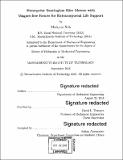Homopolar bearingless slice motors with magnet-free rotors for extracorporeal life support
Author(s)
Noh, Minkyun
DownloadFull printable version (37.87Mb)
Other Contributors
Massachusetts Institute of Technology. Department of Mechanical Engineering.
Advisor
David L. Trumper.
Terms of use
Metadata
Show full item recordAbstract
Extracorporeal life support (ECLS) is a medical therapy that uses an external blood pump and oxygenator to provide cardiac or cardiopulmonary support. One common system-related challenge is to reduce blood damage, e.g., hemolysis, which is primarily caused by the stress and heat from the pump impeller's bearing surface. Another challenge is to reduce the cost of the impeller module that is disposed after each use and therefore incurs a repeated cost. This thesis presents two types of new homopolar bearingless slice motors that levitate and rotate disk-shaped solid iron rotors. Our first bearingless motor uses a ring-shaped D2 steel rotor which generates a driving torque via hysteresis coupling. Our second bearingless motor uses a low-carbon steel rotor with surface saliencies which, in conjunction with a homopolar bias flux, makes the resulting torque-current relation similar to that of permanent-magnet synchronous machines. For both machines, permanent magnets are located on the stator to provide a homopolar bias flux to the magnet-free rotors. The bias flux passively stabilizes the rotor's axial translation and out-of-plane tilts, thereby reducing the required number of sensors and power electronics. In particular, the second bearingless motor stator includes Halbach magnet arrays for homopolar flux-biasing, which significantly improves the passive stiffness and also simplifies the design of the flux-biasing structure. The rotor's radial translation is actively stabilized by superposing a two-pole suspension flux on the homopolar bias flux. The homopolar bias flux enables us to design a winding scheme that physically decouples the torque generation and suspension force generation mechanisms. This characteristic reduces the complexity of the control algorithms. We have built the two bearingless motor prototypes, developed the associated control systems, and conducted performance tests, including pumping tests with water saline, and bovine blood. The first prototype driving a D2 steel rotor achieves a maximum rotational speed of 1730 rpm in air, where the limit comes from the position sensor's noise and the resulting power amplifier saturation and suspension failure. The second prototype driving a reluctance rotor achieves a maximum rotational speed of 5500 rpm in air, where the limit comes from the power amplifier bus voltage saturation. Based on functional requirements for ECLS, we have chosen the second bearingless motor for integration into a prototype pump module. Pumping tests are conducted with various liquids including water, saline water, and freshly obtained bovine blood. With the bovine blood, the prototype pump achieves a maximum flowrate of 2.17 L/min and maximum pump head of 120 mmHg at low flow. The blood sampled after a circulation test at 1 L/min demonstrated satisfactory hemodynamic performance including low levels of hemolysis. Integrated into extracorporeal blood pumps, the levitated magnet-free rotors are advantageous to develop low-cost disposable pump modules exhibiting a low level of hemolysis. Also, the ruggedness of the magnet-free rotors shows promise in high-speed applications, such as centrifuges and turbo-molecular pumps, and high-temperature applications, such as steam turbines and turbochargers in vehicles.
Description
Thesis: Ph. D., Massachusetts Institute of Technology, Department of Mechanical Engineering, 2018. Cataloged from PDF version of thesis. Pages 224, 230 and 231 in the original document contain text that runs off the edge of the page. Includes bibliographical references (pages 257-262).
Date issued
2018Department
Massachusetts Institute of Technology. Department of Mechanical EngineeringPublisher
Massachusetts Institute of Technology
Keywords
Mechanical Engineering.